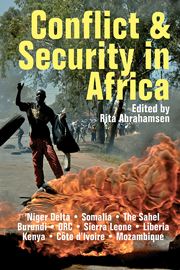1 - Introduction: Conflict & Security in Africa
Published online by Cambridge University Press: 05 October 2013
Summary
More than any other part of the globe, Africa has in the post-Cold War period been associated with conflict, insecurity and human rights atrocities. In the 1990s, Robert Kaplan's (1994) nightmare vision of ‘the coming anarchy’ epitomised the continent's perceived affinity with ethnic hatred, senseless violence and environmental dystopia. Two decades later, Pulitzer prize-winning journalist Jeffery Gettleman painted a similar picture, despairing that the continent's wars ‘never end’ but spread ‘like a viral pandemic’, making ‘quiet places’ like Tanzania ‘the lonely exceptions’ in Africa (Gettleman 2010). In academic and policy-making circles, conflict and insecurity have also come to occupy centre stage, with resource-hungry warlords and notions of ‘greed’ and ‘grievance’ playing key explanatory roles. Following the attacks of September 11, 2001 and the ensuing global war on terror, Africa has become increasingly embedded within discourses and policies of security, amidst mounting concern that the continent's so-called ‘ungoverned spaces’ will provide safe havens for terrorists intent on destroying Western civilization. In this environment, development and security policies have converged. The World Bank's 2011 World Development Report on Conflict, Security and Development is one of the latest articulations of this security/development nexus, describing a cycle of repeated violence in fragile states whose ‘territories can become breeding grounds for far-reaching networks of violent radicals and organized crime’ (2011:xi).
- Type
- Chapter
- Information
- Conflict and Security in Africa , pp. 1 - 12Publisher: Boydell & BrewerPrint publication year: 2013



